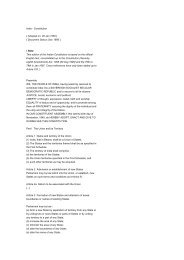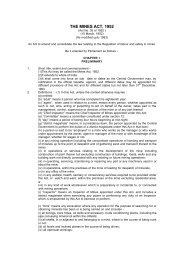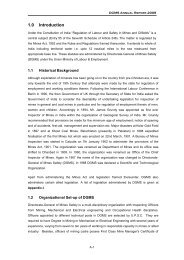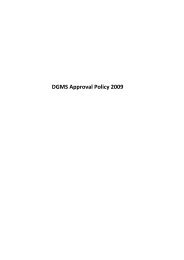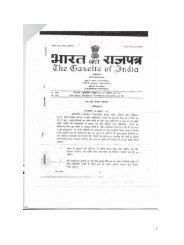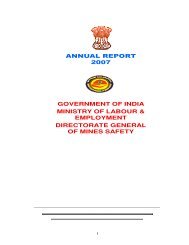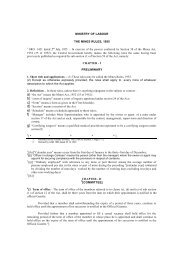Metalliferous Mines Regulations, 1961 - Directorate General of ...
Metalliferous Mines Regulations, 1961 - Directorate General of ...
Metalliferous Mines Regulations, 1961 - Directorate General of ...
Create successful ePaper yourself
Turn your PDF publications into a flip-book with our unique Google optimized e-Paper software.
(2) Suitable arrangements shall be made for persons to descend and ascend by each <strong>of</strong> such shafts or<br />
outlets. Where the shaft is vertical and more than 60 metres in depth, such arrangements shall be by means<br />
<strong>of</strong> a proper winding engine.. Every such winding engine shall be to installed and maintained as to be<br />
constantly available for use. In any doubt arises to whether any such arrangement is suitable or not, it shall<br />
be referred to the Chief Inspector for decision :<br />
Provided that, if required by the Regional Inspector by an order in writing a proper winding engine<br />
shall be provided in a shaft more than 60 metres in depth even if it is not vertical.<br />
(3) Such shafts, inclines or outlets shall not be less than 15 metres distant from one another at any point,<br />
and each shall be connected with the other by means <strong>of</strong> a walkable passage, not less than 1.8 metres<br />
high 1.5 metres wide, through the workings belowground that are being served by such shafts or<br />
outlets :<br />
Provided that outlets made before the coming into force <strong>of</strong> these regulations may be closer than 15<br />
metres but not less than 6 metres apart.<br />
(4) Whenever the connection between two outlets which are required to be maintained under sub-regulation<br />
(1) has been obstructed or found dangerous, only such persons as are necessary to clear the obstruction or<br />
to repair the dangerous part <strong>of</strong> the connection or to make a new second outlet, as the case may be, shall be<br />
employed belowground until such time as the connection has been re-established or a new second outlet<br />
has been provided.<br />
(5) The foregoing provisions <strong>of</strong> this regulation with respect to shafts and outlets shall not apply -<br />
(a) to a shaft which is being sunk or to an incline or outlet which is being made;<br />
(b) to any working for the purpose <strong>of</strong> making a connection between two or more shafts or outlets; and<br />
(c) to any working for the sole purpose <strong>of</strong> searching for or proving minerals;<br />
so long as not more than 20 persons are employed belowground at any one time in the whole <strong>of</strong> the<br />
different seams in connection with a single shaft or outlet:<br />
Provided that if the single outlet is an un-walkable shaft (other than a shaft in the course <strong>of</strong> being sunk) and<br />
exceeds 30 metres in depth, it shall be provided both with ladders and with other means <strong>of</strong> raising an<br />
lowering persons :<br />
Provided further that nothing in this sub-regulation shall be deemed to authorise the driving <strong>of</strong> roadways<br />
for the development purposes before a second outlet has been made in accordance with the said provisions.<br />
(6) The Chief Inspector may, by an order in writing and subject to such conditions as he may specify,<br />
exempt from the operation <strong>of</strong> this regulation any mine in the case <strong>of</strong> which special difficulties exist<br />
which in his opinion make compliance with the provisions there<strong>of</strong> not reasonably practicable.<br />
69. Working shafts and winzes – (1) Every shaft in use or in course <strong>of</strong> being sunk and every other outlet<br />
shall be made and kept secure.<br />
(2) Every shaft (and every winze or raise intended to be used for purposes <strong>of</strong> winding or haulage) in the<br />
course <strong>of</strong> being sank shall be provided with a permanent lining <strong>of</strong> metal, concrete or masonry, which shall<br />
at no time be more than six metres from the bottom <strong>of</strong> the shaft or winze:<br />
Provided that where iron or steel rings with a substantial lagging are used below the permanent lagging and<br />
are kept close to the bottom <strong>of</strong> the shaft, this distance may be increased to not more than 20 metres:<br />
If any doubt arises as to whether the strata are stable or not, it shall b referred to the Chief Inspector for<br />
decision.





